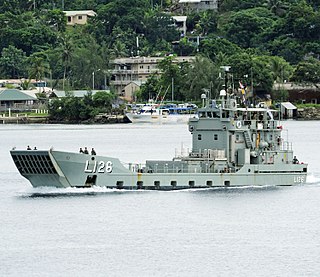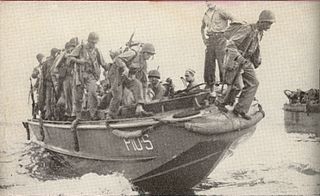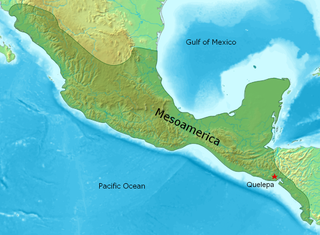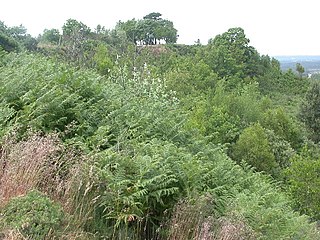
HMPNGS Buna is a Balikpapan-class heavy landing craft operated by the Papua New Guinea Defence Force (PNGDF). Prior to 1974, the vessel was called HMAS Buna and was operated by the Royal Australian Navy (RAN).

HMPNGS Lakekamu is Balikpapan-class landing craft heavy (LCH) operated by the Maritime Operations Element of the Papua New Guinea Defence Force (PNGDF). The vessel was one of eight built for the Royal Australian Navy (RAN) in the 1970s, and was commissioned into the RAN as HMAS Labuan in March 1973. Labuan was decommissioned in November 2014. She was transferred to the PNGDF for use as a training ship and was commissioned as HMPNGS Lakekamu in December 2014.
HMPNGS Salamaua is a Balikpapan-class heavy landing craft operated by the Papua New Guinea Defence Force (PNGDF). Prior to 1974, the vessel was called HMAS Salamaua and was operated by the Royal Australian Navy (RAN).

Amphibious warfare is a type of offensive military operation that today uses naval ships to project ground and air power onto a hostile or potentially hostile shore at a designated landing beach. Through history the operations were conducted using ship's boats as the primary method of delivering troops to shore. Since the Gallipoli Campaign, specialised watercraft were increasingly designed for landing troops, materiel and vehicles, including by landing craft and for insertion of commandos, by fast patrol boats, zodiacs and from mini-submersibles.

Landing Ship, Tank (LST), or tank landing ship, is the naval designation for ships first developed during World War II (1939-1945) to support amphibious operations by carrying tanks, vehicles, cargo, and landing troops directly onto shore with no docks or piers. This enabled amphibious assaults on almost any beach. The bow of the LST had a large door that would open with a ramp for unloading the vehicles. The LST had a special flat keel that allowed the ship to be beached and stay upright. The twin propellers and rudders had protection from grounding. The LSTs served across the globe during World War II including in the Pacific War and in the European theatre.

Roll-on/roll-off ships are vessels designed to carry wheeled cargo, such as cars, trucks, semi-trailer trucks, trailers, and railroad cars, that are driven on and off the ship on their own wheels or using a platform vehicle, such as a self-propelled modular transporter. This is in contrast to lift-on/lift-off (LoLo) vessels, which use a crane to load and unload cargo.

The Balikpapan class is a ship class of eight heavy landing craft. All eight were originally laid down by Walkers Limited for the Australian Army in the early 1970s. A reorganisation of watercraft responsibilities in the Australian military meant the landing craft were to be operated by the Royal Australian Navy (RAN), with seven commissioned directly into RAN service during 1973 and 1974, and lead ship Balikpapan transferred from the army to the navy. During the leadup to the independence of Papua New Guinea in 1975, two of the vessels were transferred to the new Papua New Guinea Defence Force (PNGDF).

The Canberra class is a ship class of two Landing Helicopter Dock (LHD) ships built for the Royal Australian Navy (RAN). Planning to upgrade the navy's amphibious fleet began in 2000, based on Australian experiences leading the International Force for East Timor peacekeeping operation. With a new climate for growing Australian Navy spending, a desire existed for forward defence capability for landing and supporting troops on Asian territory, that had never existed in Australian history, even with the old Majestic-class light fleet carriers, HMAS Melbourne and HMAS Sydney in the 1970s. In 2004, French company Direction des Constructions Navales (DCN) and Spanish company Navantia were invited to tender proposals, with DCN offering the Mistral-class amphibious assault ship and Navantia proposing the "Buque de Proyección Estratégica" design. The Spanish design was selected in 2007, with Navantia responsible for construction of the ships from the keel to the flight deck, and BAE Systems Australia handling the fabrication of the superstructure and fitting out.

The Landing Craft Personnel (Large) or LCP (L) was a landing craft used extensively in the Second World War. Its primary purpose was to ferry troops from transport ships to attack enemy-held shores. The craft derived from a prototype designed by the Eureka Tug-Boat Company of New Orleans, Louisiana, USA. Manufactured initially in boatyards in and around New Orleans, as requirements grew it was produced in a number of yards around the United States. Typically constructed of pine planks and plywood, and fitted with some armor plate, this shallow-draft boat with a crew of 3, could ferry an infantry platoon of 36 to shore at 8 knots (13 km/h). Men generally entered the boat by walking over a gangplank from the boat deck of their troop transport as the LCP(L) hung from its davits. When loaded, the LCP(L) was lowered into the water. Soldiers exited the boat by jumping or climbing down from the craft’s bow or sides.

The ramped craft logistic (RCL) is a type of landing craft operated by 17 Port and Maritime Regiment RLC of the Royal Logistic Corps of the British Army. From the early 1980s onwards it was deployed to replace the RPL. One of their first roles was to provide logistical support during the setting up of the garrison in the Falkland Islands immediately after the Falklands War - this role was conducted by the two first of class, Arromanches and Antwerp. RCLs were originally procured for UK, Cyprus and Hong Kong, and are now only stationed at the military port at Marchwood, near Southampton, after the two based at the British base at Akrotiri, Cyprus were sold in 2014. They are slowly being withdrawn from service, as of 2015.

HMAS Wewak was the fifth ship of the Balikpapan class of heavy landing craft operated by the Royal Australian Navy (RAN).

An amphibious warfare ship is an amphibious vehicle warship employed to land and support ground forces, such as marines, on enemy territory during an amphibious assault. The largest fleet of these types is operated by the United States Navy.

The Double Eagle is a remotely operated vehicle (ROV) built by the Swedish defence company Saab Underwater Systems AB and used for the disposal of naval mines.

Quelepa is an important archaeological site located in eastern El Salvador. Generally considered to have been settled by the Lenca people, the site was founded around 400 BC, in the Late Preclassic period. The inhabitants constructed a platform from plaster and pumice and rebuilt it a number of times. Artefacts recovered during the excavations of the site indicate that the local population depended upon subsistence agriculture, these artefacts included metates and comales. The site belonged to the Mesoamerican cultural region. Quelepa means "stone jaguar" in the Lenca language, probably in reference to the large Jaguar Altar found at the site.
Airship Industries was a British manufacturers of modern non-rigid airships (blimps) active under that name from 1970 to 1990 and controlled for part of that time by Alan Bond. The first company, Aerospace Developments, was founded in 1970, and a successor, Hybrid Air Vehicles, remains active as of 2018. Airship Industries itself was active between 1980 and 1990.

The Holland class was a class of six protected cruisers of the Royal Netherlands Navy. The class was built in two groups, each consisting of three ships.

The ramped cargo lighter or RCL was a landing craft used in many parts of the world during the Second World War. Designed in Canada and manufactured in Vancouver and Toronto, its primary purpose was lighterage work following assault landings. The RCL also provided water transport in coastal operations. These lighters were built in sections to simplify shipping and assembled in the theatre of operations.

Caesar's Camp is an Iron Age hill fort straddling the border of the counties of Surrey and Hampshire in southern England. The fort straddles the borough of Waverley in Surrey and the borough of Rushmoor and the district of Hart, both in Hampshire. Caesar's Camp is a Scheduled Ancient Monument with a list entry identification number of 1007895. It lies approximately 3 kilometres (1.9 mi) north of the town of Farnham, and a similar distance west of Aldershot. The hillfort lies entirely within the Bourley and Long Valley Site of Special Scientific Interest. Caesar's Camp is a multivallate hillfort, a fort with multiple defensive rings, occupying an irregular promontory, with an entrance on the south side. The site has been much disturbed by military activity, especially at the southeast corner. The remains of the hillfort are considered to be of national importance.

The HMBS Lawrence Major is a support vessel operated by the Royal Bahamas Defence Force. She was built in the Netherlands by The Damen Group, to an adaptation to its Damen Stan Lander 5612 design.
"Defence Standard 00-3/Issue 3- Design Guidance For The Transportability Of Equipment", 27 May 1985, UK Ministry of Defence




















